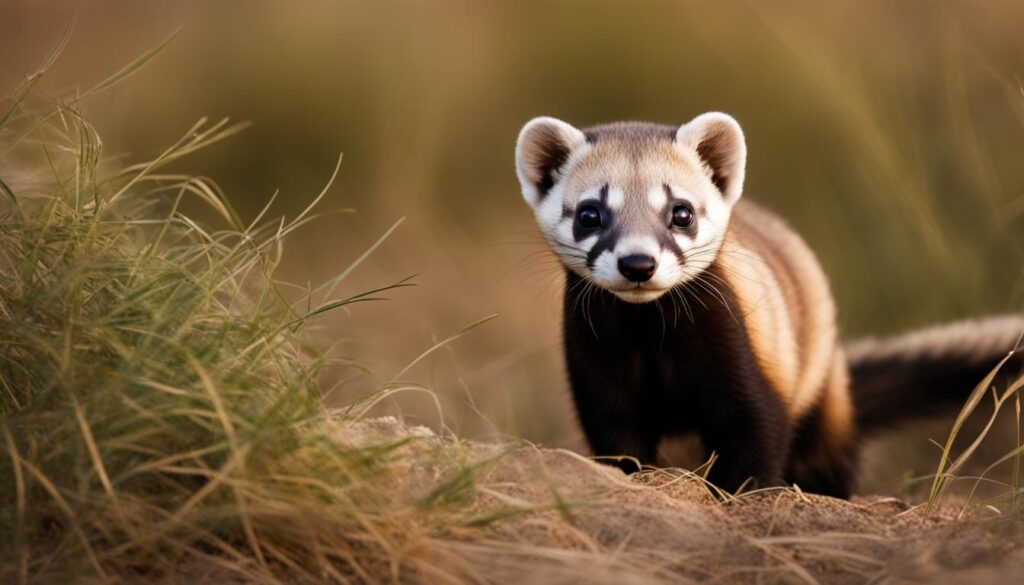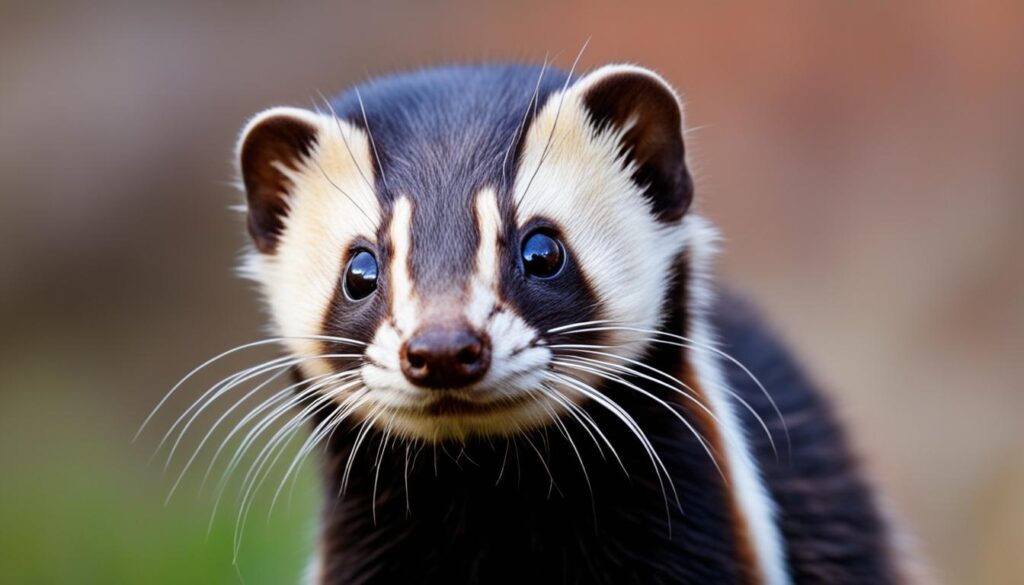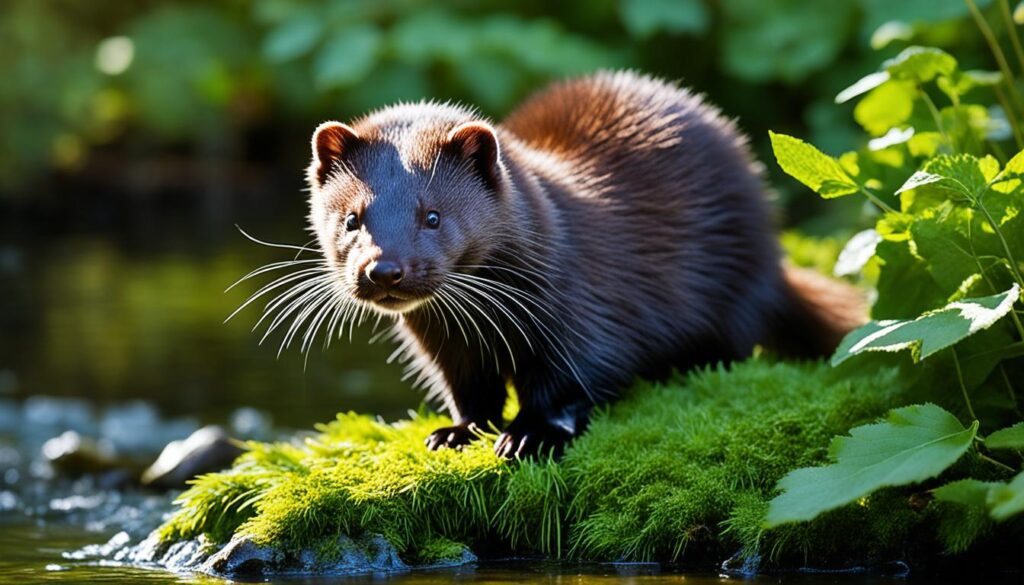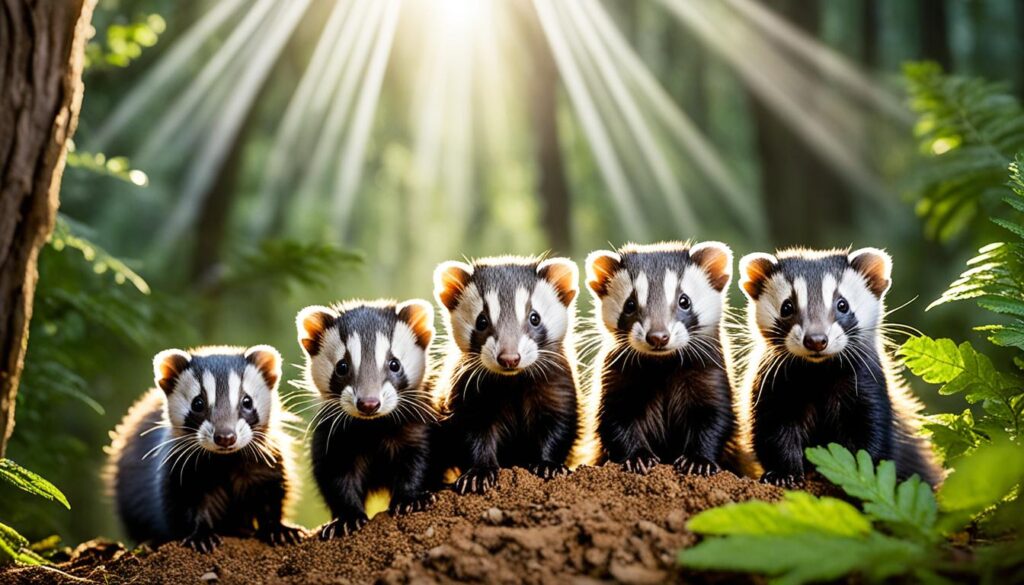Have you ever noticed that there are many animals in the animal kingdom that look very similar to ferrets? These animals have comparable physical features and behaviors as ferrets, which can sometimes cause confusion for onlookers. From their slender bodies to their long tails and cute faces, these animals fascinate us with their striking resemblance to ferrets.
Key Takeaways:
- There are multiple animals within the Mustelidae family that resemble ferrets.
- These animals include weasels, martens, polecats, minks, otters, wolverines, and stoats.
- While they may share similarities in appearance, each of these animals has its own unique characteristics.
- Ferret badgers are lesser-known creatures that deserve further study and conservation efforts.
- Understanding these captivating animals helps us appreciate the diversity of the animal kingdom.
Animals That Resemble Ferrets Within the Mustelidae Family
The Mustelidae family is home to a diverse range of species, many of which bear a striking resemblance to ferrets. Within the mustela genus alone, there are several animals that share similarities in appearance, behavior, or both. Let’s explore some of these fascinating creatures from the Mustelidae family that resemble ferrets:
- Weasels
- Martens
- Polecats
- Minks
- Otters
- Wolverines
- Stoats
Whether it’s their slender bodies, elongated noses, or mischievous behavior, these animals capture the essence of the lovable ferret in their own unique ways.
Weasels
“Weasels may be small, but they pack a punch when it comes to resembling ferrets. With their long, slender bodies and short legs, they share a similar physique. However, weasels are known for their feisty nature and are experts at maneuvering through tight spaces.”
Martens
Martens are another group of animals within the Mustelidae family that bear a resemblance to ferrets. Known for their bushy tails and graceful movements, martens exhibit a similar size and shape to ferrets. They come in a variety of species, each with its own unique characteristics and habitats.
Polecats
Polecats, including the European polecat and the North American polecat, are often mistaken for ferrets. They share many physical traits, such as their slender bodies and long tails. However, polecats have a distinct musky scent and are more closely related to wild ferrets than their domestic counterparts.
Minks
Minks are long, sleek animals that resemble ferrets in both appearance and behavior. They are characterized by their fur coats, which can vary in color depending on the species. The American mink and the European mink are two well-known varieties, each with its own unique qualities.
Otters
Otters, particularly the Eurasian or European Otter, bear a resemblance to ferrets with their slinky bodies and short legs. However, otters primarily inhabit aquatic environments and have adapted to a semi-aquatic lifestyle. Their size can vary greatly depending on the species, from the Asian small-clawed otter to the Giant Otter of South America.
Wolverines
Wolverines may have a stocky physique, but their facial features are reminiscent of a ferret. With their round heads, short snouts, and thick fur, wolverines have a distinct appearance. However, they are larger and more robust compared to the average ferret.
Stoats
Stoats are a well-recognized member of the Mustelidae family, sharing resemblances with both ferrets and weasels. They are known for their long, slender bodies, white winter coats, and distinctive black-tipped tails. Stoats exhibit color variations depending on the season, making them a visually captivating species within the family.
https://www.youtube.com/watch?v=5E0ZEv4Az-c
These animals from the Mustelidae family offer a glimpse into the incredible diversity of creatures that resemble ferrets. From weasels and martens to polecats and stoats, each species showcases its own unique traits and adaptations. Whether you’re a fan of ferrets or simply intrigued by nature’s fascinating creations, exploring these Mustelidae family members is sure to captivate your imagination.
Weasels: Similar but Smaller than Ferrets
When it comes to animals similar to ferrets, weasels are often mistaken for their furry counterparts due to their strikingly similar appearance. However, there are distinct differences between these two animals. Weasels are smaller in size and possess a more aggressive nature compared to ferrets.
Male weasels typically measure around 20-22 centimeters in length, while females are slightly smaller at around 15-18 centimeters. Despite their small stature, weasels are known for their ability to be swift and agile hunters.
Unlike ferrets, weasels are not commonly kept as pets, primarily due to their aggressive behavior. Their innate instinct to hunt and their territorial nature make them unsuitable companions for domestication.

Weasels vs. Ferrets: A Quick Comparison
| Characteristics | Weasels | Ferrets |
|---|---|---|
| Size (Length) | 20-22 centimeters (males) 15-18 centimeters (females) |
Approximately 40 centimeters |
| Aggression | More aggressive | Generally docile |
| Pet Suitability | Not suitable as pets due to aggression | Commonly kept as domestic pets |
While weasels and ferrets may look alike at first glance, their differences in size and temperament establish them as distinct members of the Mustelidae family. As we continue our exploration of animals similar to ferrets, we will uncover more fascinating creatures that share common features but possess unique characteristics of their own.
Black-Footed Ferret: The Closest Relative to Domestic Ferrets
The black-footed ferret is the most similar animal to the domestic ferret. Once thought to be extinct, a small population of black-footed ferrets was discovered in Wyoming in 1981. These incredible creatures weigh around 2 pounds and measure about 18 inches in length.
Black-footed ferrets have a distinct appearance with black outlines on their feet, ears, face, and tail, which sets them apart from their domestic cousins. While they may resemble domestic ferrets, it’s important to note that black-footed ferrets are wild animals and are not suitable as pets.

“The black-footed ferret is a remarkable species that shares a close kinship with domestic ferrets. Their rediscovery and ongoing conservation efforts have brought hope for the survival of this endangered species.”– Wildlife Conservationist
A Comparison of Black-Footed Ferrets and Domestic Ferrets
| Aspect | Black-Footed Ferrets | Domestic Ferrets |
|---|---|---|
| Size | About 18 inches in length | Vary in size, averaging around 20 inches in length |
| Weight | Around 2 pounds | Varies, typically between 1.5 to 4 pounds |
| Appearance | Distinct black outlines on feet, ears, face, and tail | Variety of colors and patterns, depending on the breed |
| Habitat | Native to the grasslands of North America | Domesticated and kept as pets worldwide |
| Behavior | Primarily nocturnal and solitary | Social and playful, often kept in pairs or groups |
As the closest relative to domestic ferrets, black-footed ferrets play a crucial role in highlighting the importance of species conservation and the need to protect and preserve their natural habitats.
Martens: Similar Size and Shape to Ferrets
In addition to weasels and polecats, another group of animals within the Mustelidae family that closely resemble ferrets are martens. These slender-bodied creatures share a similar size and shape with ferrets, making them intriguing counterparts in the animal kingdom.
Martens have bushy tails and large paws, which enable them to navigate their forested habitats with ease. Their fur can vary in color depending on the species, ranging from dark brown to reddish-brown and even yellowish-brown.
One example is the Pine Marten (Martes martes), which exhibits notable resemblance to ferrets. The males have a body length of 51-54 centimeters, while the females measure slightly shorter at 46-54 centimeters. Their agile bodies and compact size make them skilled climbers and hunters in their natural environment.
Comparison between Ferrets and Martens
| Ferrets | Martens |
|---|---|
| Long, slender bodies | Similar size and shape to ferrets |
| Domesticated and kept as pets | Wild animals |
| Varied coat colors | Fur color varies by species |
| Distinctive black markings on face, feet, and tail | Bushy tails and large paws |
“Martens, like ferrets, possess a charm that stems from their lithe bodies and captivating features. Though their habitats may differ, their uncanny resemblance to ferrets is evident, sparking our curiosity about the diverse world of Mustelidae.” – We Love Wildlife Magazine
Whether prowling through trees or exploring the undergrowth, martens captivate us with their striking appearance and agile movements. These animals add depth to the fascinating world of animals similar to ferrets, offering a unique perspective on the diversity of the Mustelidae family.

European Polecat: Ancestor to the Ferret
The European polecat, a close relative of the domestic ferret, is believed to be one of their ancestors. This species shares a similar appearance to ferrets but is larger in size. Male polecats measure approximately 55 centimeters in length, while females measure around 50 centimeters.
An interesting characteristic of polecats is their ability to emit a pungent musky odor to mark their territory. This marking behavior makes them unsuitable as domestic pets, unlike their descendants, the ferrets.
The European polecat, with its historical significance as an ancestor to the ferret, plays an essential role in understanding the evolution and lineage of these captivating creatures.

European Polecat Description
| Characteristics | Measurement |
|---|---|
| Length of male polecats | Approximately 55 centimeters |
| Length of female polecats | Around 50 centimeters |
| Odor marking | Pungent musky odor |
Mink: Long, Furry Animals That Resemble Ferrets
In the fascinating world of Mustelidae family, minks stand out as long, furry creatures that bear a striking resemblance to their distant relatives, ferrets. With their sleek bodies and dense fur, minks captivate us with their charming appearance and playful nature. Let’s explore more about these captivating animals!

Minks are found in both North America and Europe, with slight variations between the two species. The American mink is slightly smaller in size compared to its European counterpart. However, both species share similar physical characteristics that resemble ferrets.
On average, minks measure around 55 centimeters in length, making them larger than domestic ferrets. Their bodies are elongated and slender, with short legs and a distinctive tapered tail. The fur of minks can vary in color, ranging from dark brown to black, adorned with shades of silver or white on their undersides.
The Agile Swimmers of the Mustelidae Family
Minks are renowned for their exceptional swimming abilities. With their streamlined bodies and webbed feet, they navigate through water with grace and ease. Their diet primarily consists of aquatic prey such as fish, frogs, and crustaceans. Minks are also skilled hunters on land, preying on small mammals and birds.
Did you know?
Minks have been known to dive up to 5 meters in search of food, showcasing their remarkable agility and adaptability.
Intriguing Adaptations of the Minks
Minks possess fascinating adaptations that contribute to their survival in diverse habitats. Their fur is water-resistant, keeping them dry even during their aquatic expeditions. Additionally, minks have scent glands that produce a musky odor, aiding in territorial marking and communication with other minks.
Fun Fact:
Minks have an excellent sense of smell and hearing, which helps them navigate their surroundings and detect potential threats.
Minks: A Balance of Beauty and Ferocity
While minks may captivate us with their striking appearance, it’s important to remember that they are still wild animals. Minks are known for their fierce and territorial nature, defending their territories and young when necessary. It is essential to admire these creatures from a safe distance and appreciate their natural beauty in their native habitats.
In summary, minks are captivating members of the Mustelidae family that closely resemble ferrets. With their long, furry bodies and exceptional swimming abilities, they demonstrate a remarkable balance between beauty and ferocity. Let us continue to appreciate and protect these magnificent creatures in their natural environments.
Otters: Slinky-Bodied Animals with Similarities to Ferrets
When it comes to animals that resemble ferrets, otters are among the most fascinating. Particularly, the Eurasian or European Otter shares some striking similarities with ferrets. These aquatic or semi-aquatic creatures have long, slinky bodies and short legs, just like their ferret counterparts.
However, it’s important to note that otters come in a wide range of sizes, depending on the species. For instance, the Asian small-clawed otter measures around 60 centimeters in length, while the Giant Otter can reach an impressive length of up to 180 centimeters, making it one of the largest otter species in the world.
Let’s take a closer look at these marvelous animals and discover more about their unique characteristics:
The Eurasian Otter
The Eurasian Otter, also known as the European Otter, is one of the most well-known otter species and closely resembles ferrets in its appearance. These sleek creatures have a sinuous body, short limbs, and webbed feet, all of which aid in their superb swimming abilities.
Eurasian otters are well-adapted to life in freshwater and coastal ecosystems, where they rely on their agility and sharp claws to catch fish, amphibians, and crustaceans. They have a streamlined body, enabling them to glide effortlessly through the water in search of prey.
Here’s a table comparing the sizes of different otter species:
| Species | Average Length |
|---|---|
| Asian small-clawed otter | 60 centimeters |
| Giant Otter | Up to 180 centimeters |
As you can see, otters can vary significantly in size, ranging from the petite Asian small-clawed otter to the incredibly impressive Giant Otter.
Now, let’s explore some fascinating facts about otters:
“Otters are known for their playful behavior, often engaging in frolicking and sliding down riverbanks. Their social nature and love for water make them delightful creatures to observe.”
It’s clear that otters share a slinky-bodied resemblance with ferrets. Although they are primarily associated with aquatic habitats, otters’ remarkable adaptability and captivating behaviors make them a truly enchanting group of animals.

Wolverines: Stocky-Bodied Animals That Resemble Ferrets

Wolverines are fascinating animals with a unique appearance that bears resemblance to ferrets. They are known for their stocky bodies, short and thick legs, and a round, blunt head with a short, pointed snout. While their head may resemble that of a ferret, wolverines have a more heavyset and muscular body compared to their ferret counterparts.
These remarkable creatures can measure between 65-105 centimeters in length and weigh around 9-17 kilograms, making them one of the larger animals similar to ferrets. Wolverines are well-adapted to harsh environments and are known for their strength and tenacity.
Although wolverines may share some physical similarities with ferrets, it is important to note that they are wild and solitary animals. They have distinct behaviors and characteristics that set them apart from domesticated ferrets.
Notable Features of Wolverines:
- Stocky Build: Wolverines have a sturdy physique with a heavyset, muscular body.
- Short and Thick Legs: Their legs are designed for traversing various terrains, aiding in their survival in the wild.
- Round, Blunt Head: Wolverines have a distinctive head shape with a short, pointed snout.
“Wolverines are known for their strength and resilience, making them one of the fascinating animals in the mustelid family.”
While wolverines may not be as commonly associated with ferrets as some other Mustelidae family members, their unique characteristics and resemblance make them a captivating addition to the discussion of animals that resemble ferrets.
| Feature | Description |
|---|---|
| Size | Between 65-105 centimeters in length |
| Weight | Average weight of 9-17 kilograms |
| Body Structure | Stocky and muscular |
| Head Shape | Round and blunt with a short, pointed snout |
Stoats: Recognizable Mustelids That Resemble Ferrets
Stoats, part of the Mustela family, are easily recognizable members of the mustelid group. They bear a striking resemblance to both ferrets and weasels. With their long, slender bodies and distinctive black-tipped tails, stoats have a unique appearance that sets them apart.
While stoats are slightly smaller than the average ferret, they are larger than weasels, making them a distinct species within the mustelid family. Stoats have the ability to change the color of their fur depending on the season. In the summer, their fur takes on a beautiful chestnut brown hue, while in winter, they transition to a striking white coat, often referred to as ermine.
Stoats are agile predators, equipped with sharp teeth and excellent hunting skills. They are known for their ability to take down prey larger than themselves, showcasing their impressive strength and adaptability. Their slender bodies allow them to navigate narrow spaces with ease, making them highly effective hunters in diverse environments.
Here is a brief comparison of the sizes of stoats, ferrets, and weasels:
| Mustelid | Average Length |
|---|---|
| Stoat | 27-40 cm |
| Ferret | 40-50 cm |
| Weasel | 15-25 cm |
As the table demonstrates, stoats fall in between ferrets and weasels in terms of size, showcasing their unique characteristics within the mustelid family.
The adaptability and resilience of stoats make them fascinating creatures to observe in their natural habitats. Whether in their brown summer coat or white winter fur, they are sure to captivate nature enthusiasts with their recognizable appearance and impressive hunting skills.

Stoats, with their distinctive features and resemblance to both ferrets and weasels, are an essential part of the mustelid family. Their ability to adapt to changing environments and their agile hunting skills make them a truly remarkable species within the animal kingdom.
Rarely Seen Mustelids: Badgers and Fisher
While badgers and fishers may not receive as much attention as other members of the Mustelidae family, they are fascinating creatures in their own right. Let’s take a closer look at these rarely seen mustelids.
European Badger
The European badger (Meles meles) is one of the most well-known badger species. These sturdy creatures are found across Europe, including the United Kingdom. They have a distinctive black and white face with a stocky body, strong claws, and short legs.
| Species | Length | Weight |
|---|---|---|
| European Badger (Meles meles) | Average 75 – 100 cm (30 – 39 inches) | Average 10 – 15 kg (22 – 33 lbs) |
The European badger is primarily nocturnal and spends its time digging extensive burrow systems, called “setts,” where they live in social groups known as clans. They are omnivorous, feeding on a variety of foods including earthworms, fruits, small mammals, and carrion.
Fisher
The fisher (Pekania pennanti) is a species of mustelid native to North America. They are known for their elusive nature and are rarely seen in the wild. Fishers have long, slender bodies with dark brown fur and are skilled climbers and swimmers.
| Species | Length | Weight |
|---|---|---|
| Fisher (Pekania pennanti) | Average 75 – 120 cm (30 – 47 inches) | Average 1.8 – 6.8 kg (4 – 15 lbs) |
Fishers are primarily carnivorous and prey on a variety of animals, including small mammals, birds, and even porcupines. They are skilled hunters and are known for their agility and ability to navigate through dense forests.
Greater and Lesser Grison
The greater grison (Galictis vittata) and lesser grison (Galictis cuja) are two species of mustelids found in South America. These lesser-known members of the Mustelidae family have a weasel-like appearance with long, slender bodies and short legs.
| Species | Length | Weight |
|---|---|---|
| Greater Grison (Galictis vittata) | Average 45 – 65 cm (18 – 26 inches) | Average 1.5 – 3.5 kg (3.3 – 7.7 lbs) |
| Lesser Grison (Galictis cuja) | Average 39 – 45 cm (15 – 18 inches) | Average 1 – 1.5 kg (2.2 – 3.3 lbs) |
Greater and lesser grisons are primarily carnivorous, hunting small vertebrates and invertebrates. They are also known to scavenge on carrion. These elusive creatures inhabit a variety of habitats, including forests, grasslands, and wetlands.
While badgers and fishers may not always steal the spotlight, they are fascinating mustelids worth appreciating. Their unique characteristics, behaviors, and habitats contribute to the rich diversity of the Mustelidae family.

Overlooked Mustelids: Ferret-Badgers, Tayra, and Grisons
Ferret-badgers, tayras, and grisons are often overlooked among mustelids. These unique creatures deserve our attention for their distinct characteristics and fascinating adaptations.
Ferret-Badgers
Ferret-badgers are small and intriguing animals that resemble a mix of different species. They have a long, slender body like a ferret, but their head and snout shape are reminiscent of a badger. Their fur can vary in color, including shades of brown, black, and gray.

Tayra
Tayras are predominantly found in Latin America, particularly in the rainforests. They have long limbs that distinguish them from other mustelids. Tayras are agile climbers, which allows them to move efficiently through the trees in search of food. Their fur is typically dark brown or black.
Grisons
Grisons are mustelids that share some resemblance to the ratel, also known as the honey badger. However, grisons have a smaller stature and a more weasel-like structure. They have a unique coloration pattern, with a dark face and lighter fur on the body. Grisons are found in parts of Europe and Asia.
In conclusion, ferret-badgers, tayras, and grisons are often overlooked among mustelids. These fascinating animals deserve our attention and appreciation for their unique traits and adaptations. By learning more about these overlooked mustelids, we can gain a deeper understanding of the diversity and beauty of the animal kingdom.
Polecats and Weasels: Agile Mustelids That Look Like Ferrets
Polecats and weasels are agile mustelids that bear a striking resemblance to ferrets. Despite their similar appearances, these animals have distinct characteristics of their own. Let’s explore the unique features of polecats and weasels in more detail.
Polecats
One of the main members of the Mustelidae family, polecats come in various species, including the European polecat and the North American polecat. With their long, slender bodies and furry coats, polecats often get mistaken for generic ferrets. However, they differ in key ways.
European polecats (Mustela putorius) are larger than domestic ferrets, with males measuring around 55 centimeters in length and females measuring 50 centimeters. They are known for their gorgeous brown fur with white underparts. Despite their alluring appearance, polecats emit a strong, musky odor to mark their territory, making them less suitable as pets.
North American polecats, also known as black-footed ferrets (Mustela nigripes), are the closest relatives to domestic ferrets. With their distinct markings, including black outlines on their feet, ears, face, and tail, they share a strong resemblance. However, black-footed ferrets are wild animals and not suitable for domestication. They weigh around 2 pounds and measure approximately 18 inches in length.
Weasels
Weasels are another group of agile mustelids that look like ferrets. These small, nimble creatures include species such as the long-tailed weasel (Mustela frenata) and the mountain weasel (Mustela altaica).
Long-tailed weasels are found in North America, and their slender bodies measure around 20-40 centimeters in length. With their reddish-brown fur and distinct white underparts, they are often portrayed as generic weasels in the media.
Mountain weasels are native to various regions in Asia, including the Himalayas. Similar to other mustelids, mountain weasels have elongated bodies and short legs. They are slightly larger than long-tailed weasels, measuring around 25-30 centimeters in length.
While polecats and weasels share similarities with ferrets, it’s essential to recognize their unique characteristics. Each of these agile mustelids has adapted to various habitats and plays a crucial role in their ecosystems.

Little-Known Ferret Badgers in Bangladesh
Ferret badgers are fascinating creatures that are relatively unknown, even in international conservation circles. These elusive animals reside in the beautiful country of Bangladesh, where they have managed to remain hidden from the spotlight for many years. However, recent discoveries have shed light on the presence of two distinct species of ferret badgers within the borders of Bangladesh – the large-toothed ferret badger and the small-toothed ferret badger.
Uncovering the existence of these ferret badgers in Bangladesh has been no easy feat. Their elusive nature and limited scientific evidence have made studying and understanding these creatures a complex task. Most of our knowledge about them has been derived from chance encounters, brief glimpses, and occasional camera trap footage.
The ongoing efforts to study and conserve ferret badgers in Bangladesh are crucial for unraveling the mysteries surrounding these enigmatic creatures. Camera traps have played a significant role in capturing rare sightings and helping researchers gain insights into their behavior, habits, and ecological significance.
| Ferret Badger Species | Description |
|---|---|
| Large-Toothed Ferret Badger | A species of ferret badger characterized by its distinctive large teeth and robust build. It typically inhabits various forested and hilly regions of Bangladesh. |
| Small-Toothed Ferret Badger | A smaller species of ferret badger with more delicate features and relatively smaller teeth. It can be found in a range of habitats, including grasslands, bamboo groves, and agricultural areas. |
Through continuous research and conservation efforts, we hope to uncover more about these little-known ferret badgers and their vital role in the ecosystems of Bangladesh. Understanding their behavior, habitat requirements, and conservation status will enable us to take appropriate measures to ensure their long-term survival.

Our Commitment to Protecting Ferret Badgers in Bangladesh
At our conservation organization, we are dedicated to safeguarding the unique biodiversity of Bangladesh, including the lesser-known species like ferret badgers. We strive to promote scientific research, raise awareness, and implement conservation programs that address the challenges faced by these remarkable creatures.
By working collaboratively with local communities, government agencies, and other stakeholders, we aim to protect the habitats and ensure the preservation of ferret badgers for future generations. Join us in our efforts to conserve these fascinating animals and the delicate ecosystems they call home.
Conclusion
In conclusion, we have discovered that the Mustelidae family encompasses a diverse range of animals that resemble ferrets. From weasels and polecats to martens and otters, these creatures share similarities in appearance, size, and behavior with domestic ferrets. However, each species has its own distinctive characteristics and is adapted to thrive in different environments.
While ferrets are commonly mistaken for rodents, they are actually members of the Mustelidae family, which includes various other fascinating animals. Weasels, with their smaller size and aggressive nature, are often misidentified as ferrets. On the other hand, the black-footed ferret, the closest relative to domestic ferrets, shares a striking resemblance but remains a wild species.
Other animals within the Mustelidae family, such as martens, otters, and stoats, also exhibit similarities to ferrets. Martens have bushy tails and can vary in color, while otters possess a slinky body shape and thrive in aquatic or semi-aquatic habitats. Stoats, with their long, slender bodies and distinctive black-tipped tails, resemble both ferrets and weasels.
One particularly intriguing group of mustelids that deserve further attention are the ferret badgers. These little-known creatures, found in Bangladesh, are a unique blend of different animal characteristics. Their existence was discovered through chance encounters and limited scientific evidence, emphasizing the need for continued research and conservation efforts to safeguard their populations.










